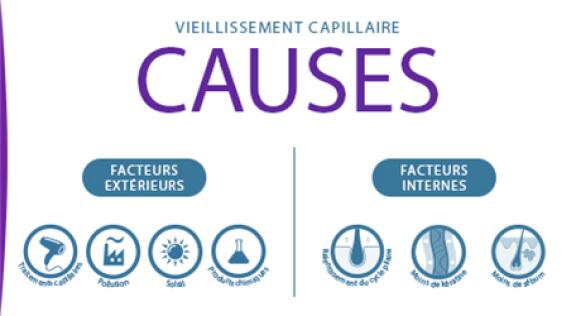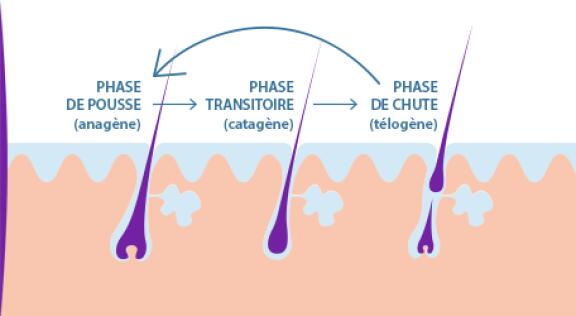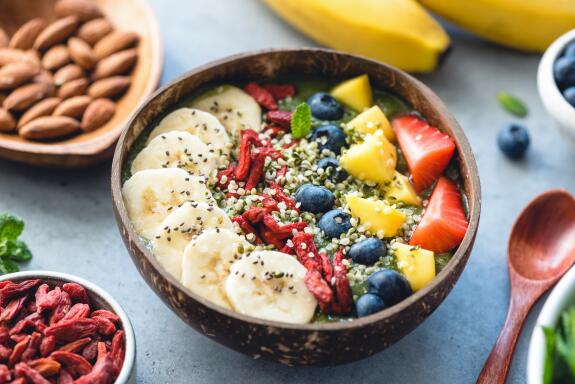- SUMMARY
- Hair aging
Hair aging
- What are the signs of aging of hair?
- Is it normal for hair to stop growing?
- Hair loss and loss of hair volume: what's the difference?
- Porous hair: how to identify and control it
- What should you do when hair becomes weaker and thinner?
- Hair loss: what should you do when your hair is falling out in clumps?
Hair aging
From the age of 45, it is not uncommon to notice changes in the type and quality of your hair. It becomes drier, turns gray, and loses its thickness, which can lead to an overall feeling of loss of volume. This process, the aging of hair, is natural. Find out about the causes, symptoms and solutions so that you can live better with hair aging each day.

Hair aging: when time also takes its toll on our hair
In an elevator, standing in front of a mirror, what you first notice is that your skin is changing: the appearance of wrinkles, fine lines and some spots, a slightly different face shape...
However, just like with skin, time takes its toll on our hair. There are many causes of hair aging. Firstly, there are internal and genetic factors like hormonal changes, less micro-circulation of blood in the scalp, reduction in keratin (hair is mostly made up of this protein) production, or even a decline in sebum production (the lipid film produced by sebaceous glands, which hydrates and protects hair against dryness).
And then, over time, the activity of the hair follicles on the scalp decreases, and the life cycle of the hair slows down, meaning growth is slower as well.
Lastly, exterior aggressions (environmental or mechanic) such as the sun, pollution or overly harsh shampoos and brushing, are also factors which play an important role in hair aging, just like repeated chemical treatments: dyes, bleaching, highlights and balayage. And it's important not to forget the hairdryers and hair irons that some people use regularly, and which contribute to the aging of hair.
What are the various symptoms of hair aging?
Thinner hair, and hair mass that has lost density
Your hair is more fragile, thinner and has less volume, and is more difficult to style. Is your ponytail getting thinner and thinner? You are experiencing one of the symptoms of aging of hair: loss of hair density. More or less dependent on an individual's genetics, the number and thickness of hair strands varies over time, and drastically decreases with age. The figure is even indisputable: according to the results of a clinical study conducted by DUCRAY Dermatological Laboratories*, density reduces by 22%.
The appearance of white hair
Located at the base of the hair follicle, melanocytes are the cells responsible for hair pigmentation. The more pigment (melanin) they secrete, the darker the color of the hair. And the more time that passes, the less they produce, until they dry up completely.
A direct consequence of hair aging is when hair becomes white. Canities is another name for this irreversible,
natural process. It affects everyone, both men and women, some sooner or faster than others.
Hair grows at a slower rate, if at all
Hair grows, falls out and then grows back in a cyclical pattern, which allows for constant hair renewal. This is called the hair cycle. And unfortunately, around the age of 50, this life cycle changes. Hair grows more slowly, and there is a reduction in blood micro-circulation in the scalp, and therefore in the hair bulb.
Fewer nutrients, such as fatty acids, vitamins and minerals, which are required for good hair growth, are therefore absorbed. This leads to hair aging.
More fragile hair
During the aging process, hair texture changes. As it is naturally less hydrated and protected by the sebum produced by the sebaceous glands, and is less nourished at the roots, hair becomes thinner and more fragile.
The aging of hair results in drier hair that is more brittle, less resistant and duller. The same study conducted by DUCRAY Dermatological Laboratories demonstrates that hair strength reduces by 18% and porosity increases by 50% with hair aging.
Hair falling out
Make sure that you don't confuse hair aging with alopecia. These two phenomena are not linked and have different causes. Worn out over time, by aggressions which cause damage and by hormonal changes, the hair fiber becomes weaker and hair growth slows down. This is the aging of hair, and it is inevitable. We are all affected by this process to some extent.
In contrast, alopecia is a type of hair loss that leaves an area of the scalp more or less bald. It does not affect everyone and can present much earlier.
* Clinical, instrumental and biological study conducted on 60 Caucasian women. Comparative study between two age groups: 25-35-year-olds and over 71s.


Live better with hair aging each day
The feeling of having less hair is not necessarily a result of hair loss, but rather that with age, hair becomes thinner and ultimately loses density. So, what can you do in the case of aging of hair?
A well-balanced diet
In order to redensify the hair shaft and help restore volume to hair, change must firstly come from within. If necessary, rebalance your body by adopting a diet rich in vitamins A, E and B. The correct amount of nutrients, vitamins, amino acids and trace elements helps stimulate hair growth.
In particular, eat white fish such as cod, pollock or whiting, as these foods are rich in protein and low in fat.
And you can definitely combine this diet with food supplements that are designed to target the aging of hair.
Tailored, effective products
Another tip to fight against hair aging each day- this time for the bathroom:
- Stop using styling products such as mousses and hairsprays once and for all. Of course, they're convenient, but in reality, they do nothing but dry out and thin the hair fiber.
- Instead, invest in densifying products for thin, brittle hair. Choose hair products that are designed for the aging of hair, and that are, in particular, rich in protective antioxidants.
- When lathering your shampoo, massage your scalp with your fingertips. Doing this for one minute is sufficient. A simple action to stimulate the micro-circulation of blood, oxygenate the roots and restore a little bit of volume to your hair.
Hide your white hairs
Lastly, there are several solutions to cover white hairs, which are the first sign of hair aging. Coloring, highlights, balayage - a colorist will be able to advise you as to the most suitable approach.
Our care routines
Thin and brittle hair
Dermatological expertise
To better understand your skin and hair, discover our exclusive content and innovative care products designed to improve your quality of life..
